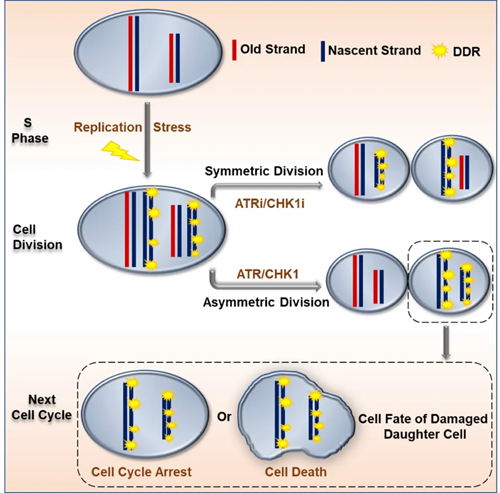

Recently, SAHZU researchers published an article on the website of Molecular Cell (click to view the full article), looking into the mysterious phenomenon of Nonrandom DNA segregation (NDS), a mitotic event in which sister chromatids carrying the oldest DNA strands are inherited exclusively by one of the two daughter cells.
SAHZU researchers observed that in NDS, while one of the daughter cells remains genomic integrity, the other daughter cell is associated with DNA damages. They revealed in the article that the nonrandom segregation and asymmetric distribution of DNA damage response protein might be induced by stress conditions of microenvironment of human cells, and that the ATR/CHK1 signaling pathway may play an essential role in mediating this mechanism.
This article shed light on a new perspective of investigation into cell biology according to Dr. YING Songmin, the co-corresponding author and professor of respiratory medicine from SAHZU. “All living organisms in the nature are pretty smart. Cells can repair themselves once there is a DNA damage inside them. When repair is not achievable, the last defense line is the nonrandom chromatid segregation which appears to be able to ‘isolate’ the damaged DNA. This is how life forms maximize our gene advantages,” said Dr. YING.
This research finding, also potentially linking to tumorigenesis, provides a possible target for developing future therapy against cancer.
Author: | Reviewer: | Editor: | Source: | Date:2020-05-05 | Views:![]()
88 Jiefang Road,Shangcheng District Hangzhou,China, 310009
1511 Jianghong Road,Binjiang District Hangzhou,China, 310014
300 Yuanju Road, Shangcheng DIstrict, Hangzhou
456 Qidi Road, Xiaoshan District, Hangzhou, China
1 Xihu Avenue, Shangcheng District, Hangzhou
Zijingang Campus of Zhejiang University, 866 Yuhangtang Road, Xihu District, Hangzhou
Please call +86-571-8971 3988 (8am-5pm, Monday through Friday)
Make an appointment online

The Second Affiliated Hospital
Zhejiang University School of Medicine
88 Jiefang Road, Hangzhou, China
+86-571-8731 5108
iao_sahzu@zju.edu.cn
The Needs of Patients and Customers Come First.
The Second Affiliated Hospital Zhejiang University School of Medicine
All Rights Reserved.

